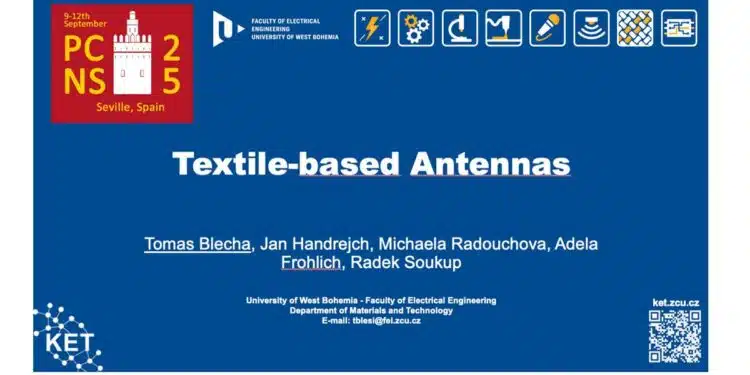The paper “Textile-Based Antennas” was presented by Tomas Blecha, University of West Bohemia, Pilsen, Czech Republic at the 5th PCNS Passive Components Networking Symposium 9-12th September 2025, Seville, Spain as paper No. 3.1.
Introduction
This article explores the design, fabrication, and application of textile-based antennas within the rapidly growing field of electronic textiles (e-textiles).
Textile antennas are lightweight, flexible, and capable of seamless integration into garments, making them ideal for wearable electronics, Internet of Things (IoT) devices, and wireless sensor networks. In addition to facilitating wireless data transmission, they can serve as strain or deformation sensors for health monitoring and structural applications.
A critical focus of the study is the development of reliable electrical interconnections between textile antennas and conventional electronic components, a challenge due to the incompatibility between standard electronic processes and textile substrates.
Key Points
- Textile antennas use conductive threads and can be fabricated through knitting, embroidery, weaving, printing, or metallization.
- Interconnection methods include soldering, sewing, hot bar and ultrasonic welding, adhesive bonding, and thermo-compression bonding.
- Electrical and mechanical performance is affected by fabrication techniques, conductive thread density, mechanical deformation, and environmental conditions such as moisture.
- Experimental investigations examined the impact of interconnection methods, embroidery density, and textile stretching on antenna resonant frequencies and reflection coefficients.
- Textile antennas show strong potential for wearable IoT, medical monitoring, and smart sensor applications, but require careful optimization for stability and durability.
Extended Summary
The study begins by highlighting the increasing adoption of e-textiles, which integrate electronic components into fabric structures. Conductive threads are the foundational elements that enable the creation of electrodes, sensors, interconnects, and passive components like planar antennas. Textile antennas have attracted attention for their unique combination of wearability, flexibility, and low weight, enabling real-time health monitoring, wireless communications, and environmental sensing.
Multiple fabrication methods are detailed, each with distinct advantages and limitations. Knitted antennas offer high flexibility and comfort but lower precision and higher resistance. Embroidered antennas provide excellent accuracy and controlled electrical parameters, though they may be less flexible. Woven antennas ensure stable impedance and robust mechanical properties but are less comfortable for wearable applications. Printing and metallization techniques allow high pattern definition but can reduce fabric breathability.
Establishing reliable electrical connections is essential for functional textile antennas. The paper analyzes several interconnection approaches, including soldering, sewing conductive threads through PCBs, hot bar and ultrasonic welding, adhesive bonding, and thermo-compression bonding. Each method is evaluated for mechanical robustness, electrical performance, and compatibility with textile materials. For instance, ultrasonic and thermo-compression bonding provide strong, localized joints ideal for e-textiles, while adhesives preserve flexibility but may degrade under washing or prolonged stress.
Experimental evaluations focus on the performance of planar bow-tie antennas produced through knitting and embroidery. The study demonstrates that interconnection methods and conductive thread configurations significantly influence the reflection coefficient (S₁₁) and resonant frequency. Embroidery density is shown to directly affect conductivity and frequency response, while mechanical stretching of knitted antennas leads to downward resonant frequency shifts due to elongation-induced geometric changes. Such behavior underscores the importance of accounting for deformation in wearable designs.
The article also demonstrates the integration of textile antennas into a modular IoT prototyping platform using ESP32-based microcontrollers and flexible textile-compatible interconnects. Tested antennas successfully resonate at 868 MHz, suitable for LoRa and LPWAN networks, validating their potential for real-world wireless communication.
Overall, textile antennas present a promising technology for wearable electronics, offering seamless garment integration and multifunctionality. However, their RF performance is inherently sensitive to mechanical stress, environmental conditions, and surface conductivity variations. Ongoing research into hybrid conductive materials, multilayer textile structures, and robust interconnection methods is essential to enhance the stability, reliability, and longevity of textile antennas in daily use.
Conclusion
Textile-based antennas represent a critical step toward practical e-textiles and wearable IoT solutions. By combining flexible conductive materials with precise fabrication and reliable interconnection techniques, these antennas can provide efficient wireless data transmission and sensing capabilities. Future progress will depend on continued innovation in materials, design optimization, and environmental durability to ensure consistent performance in real-world applications.
































